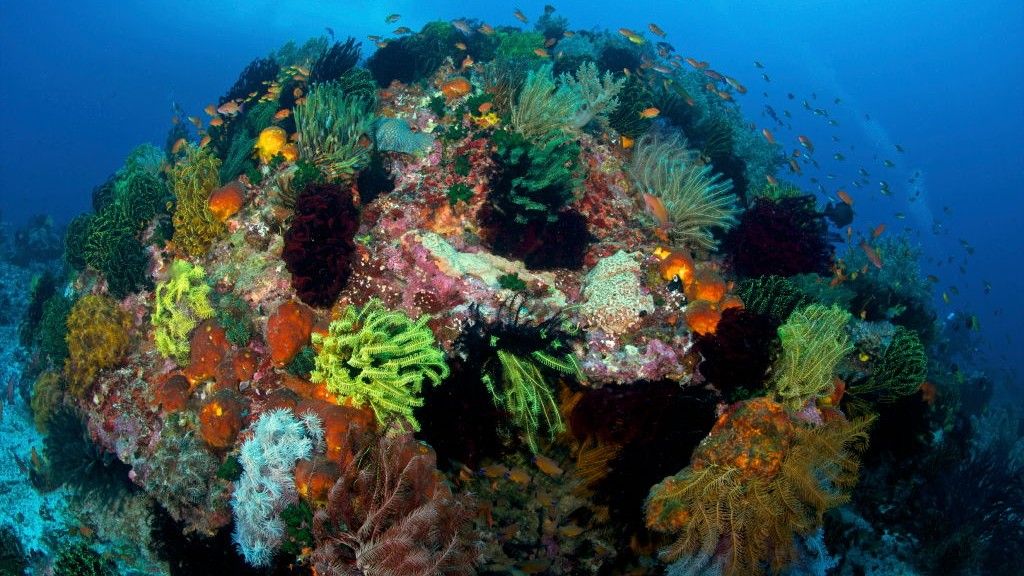QUICK FACTS
Name: Coral Triangle
Location: Ocean around the Solomon Islands, Papua New Guinea, Timor-Leste, parts of Indonesia and Malaysia, and the Philippines
Why it’s incredible: The Coral Triangle is home to 76% of known coral species in the world.
The Coral Triangle is a tropical marine region between the Pacific and Indian oceans where 76% of Earth’s coral species are found. It encompasses 2.3 million square miles (6 million square kilometers) of ocean around the Philippines, Indonesia and Papua New Guinea, and stretches south to Timor-Leste and as far east as the Solomon Islands.
Biodiversity in the Coral Triangle is much higher than in other regions with coral reefs, such as the Caribbean Sea and the southwest Pacific Ocean. Around 605 reef-building coral species inhabit the Coral Triangle — 10 times the number in the Caribbean Sea, according to an article from the U.K.’s Natural History Museum (NHM).
These corals provide a home for six of the world’s seven sea turtle species and 37% of the world’s coral reef fish species, as well as marine mammals like dolphins, dugongs, blue whales and sperm whales, according to the NHM article. This incredible array of species has earned the Coral Triangle the nickname the “Amazon of the sea.”
“This part of the world contains the highest diversity of marine species,” Nadia Santodomingo, a coral expert and marine biologist at the NHM, said in the article. “Scientists have been trying to understand why it’s so diverse for a very long time.” In fact, British naturalist and explorer Alfred Russel Wallace was working there when Charles Darwin was alive, trying to solve the same problem, she added.
Wallace traveled through the Malay Archipelago between mainland Southeast Asia and Australia, collecting specimens and developing theories regarding the region’s staggering biodiversity. He came up with what scientists call the “Wallace Line” — a gigantic biological boundary that separates the Oriental and Australian faunal regions — and proposed the theory of evolution by natural selection around the same time as Darwin.
Scientists today have more tools at their disposal to understand the region, with evidence suggesting that murkier conditions in the Coral Triangle compared with other shallow tropical waters may provide a haven for different species. The Coral Triangle has been a biodiversity hotspot for at least the past 20 million years, and this is partly thanks to a huge variety of habitat types and optimal conditions for larvae that ride on ocean currents, according to the nongovernmental organization Blue Corner Marine Research.
Research also suggests that the Coral Triangle has a plethora of species simply because diversity built up over time. Unlike temperate and polar marine regions that have undergone glaciations, tropical regions like the Coral Triangle have remained relatively stable. And what sets this region apart from other tropical seas is its unique, platform-like geology and location at the intersection between two oceans, researchers say.
Like other coral reef regions, the Coral Triangle is vulnerable to overfishing, pollution from coastal development, and ocean acidification linked to climate change — although scientists think its murky conditions may shield it somewhat.
“Corals living under continuous sediment stress seem to be more resilient, as the mud may block light, which in turn alleviates bleaching stress induced by high temperatures,” Kenneth Johnson, a paleobiologist and principal researcher at the NHM, said in the article.
Nevertheless, it’s important to protect this patch of ocean, Johnson said. “Nobody really thinks about these reefs,” he said, “but they might be the ones we really want to protect.”
Discover more incredible places, where we highlight the fantastic history and science behind some of the most dramatic landscapes on Earth.
